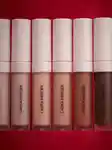How do you know which shade of concealer is right? What are the best concealers for dark circles, or breakouts? Should you apply concealer before or after foundation?
To help guide you, we spoke to two expert makeup artists, who graciously answered all our concealer queries.

Makeup by Shella Ruby Martin

What is the best way to apply concealer?
When you’re concealing dark circles
When selecting a concealer for under the eyes a hydrating formula is best.
MECCA’s Makeup Education Manager, Hannah Daniel, says it’s often better to pick a shade that is closer to your skin tone.
“There is a lot of information out there suggesting to use a concealer that’s one to two shades lighter [than your skin tone], but this will often just exacerbate the look of the under-eye bag,” she reveals.
If you’re trying to remove evidence of late nights and early mornings from under your eyes sometimes you need a little reinforcement. Before going in with a concealer, apply a light layer of a peach toned colour corrector.
This will help counteract the darkness under your eyes and means you don’t have to pack on as much concealer (which is a recipe for creasing).
Use your finger or a brush to blend to ensure ultimate coverage.
When you need extra coverage
When covering blemishes matte formulas are key. This is because high coverage, matte concealers are thicker and tend to cover more than their medium coverage, liquid counterparts.
Pro tip from our experts: if you’re concealing blemishes, avoid using the concealer’s applicator directly on the breakout.


Instead, decant some product onto the back of your hand first, then use a clean brush or finger to apply it to your face. This helps prevent spreading bacteria from your breakout back into your product.
Letting the concealer sit for a couple of minutes will also boost the coverage. When blending try to avoid blending on top of the actual blemish - instead blend around the edges to maintain a high coverage finish that isn’t cakey.
When you’re going for 'no-makeup makeup'
When going for a no-makeup makeup look you may want to skip foundation all together. Instead you can use your concealer to take a targeted approach, covering any concerns (discoloration, breakouts etc.), while still letting the rest of your skin sing.
Our advice is to pick a lightweight formula and a shade that is as close to your natural skin tone as possible for a seamless blend.
When applying your concealer, Shella recommends taking a step back from the mirror and checking your application in natural light.
“Here, in your new position, check you’re all matched up and pat your under-eye area with your fingertips,” she says. “This ensures you don’t have creases and gives you a really even and thin layer.”

What not to do when it comes to concealer
Hannah says the most common concealing mistake she sees people make is using too much product:
“When there is excess product on the skin, it is more likely to sit in fine lines and create creasing. To avoid this, I usually advise starting with a small amount of product and really working it in with your fingers or a fluffy synthetic eyeshadow blending brush.”
Meanwhile, Shella says picking the right shade is crucial: “Concealer isn’t necessarily your foundation shade,” she reveals. “Some skin tones also need more than one shade for different parts of the face.”






